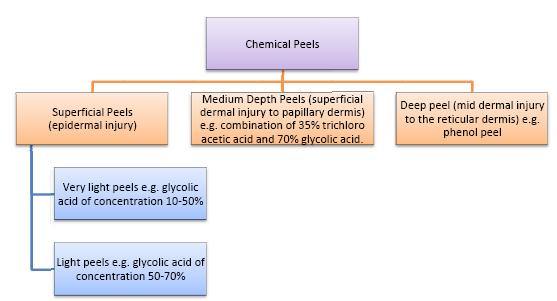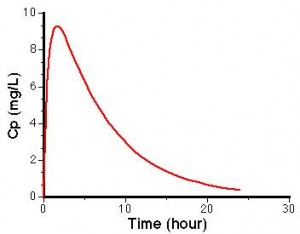Introduction
The skin is the most superficial part of the body. The signs of ageing are most visible in the skin. Although, ageing skin is not a threat to a person, it can have a detrimental effect on the psychology of a person. A look into the causes of skin ageing, the available treatments and preventive measures for this inevitable change is important to help both the already aged, as well as, the youth.
This is a 4 part article in which:
- Part 1 – Discusses the structure of skin and its different components
- Part 2 – Discusses cutaneous ageing and its causes
- Part 3 – Discusses the characteristics of ageing skin and the changes in skin appearance
- Part 4 – Discusses products and treatments for skin ageing
a) Sunscreen Agents
b) Moisturizers
c) Antioxidants
d) Make Up
e) Dermal Fillers
f) Chemical Peels (current article)
g) Botulinum Toxin
h) Estrogen and Hormonal Treatments
i) Plastic Surgery
Chemical Peels 1,2,3
It is a skin treatment technique used to improve and smooth skin texture using chemical solution that would cause the skin to blister and eventually peel off. The new skin layer would be smoother. The advantages of chemical peels are that they are efficient in facial skin rejuvenation, safer in comparison to surgical procedures, easy to use, inexpensive, patients have relatively rapid recovery time.
Preoperative Evaluation
Preoperative evaluation of the skin is done to determine a suitable chemical peel for use. The skin is evaluated on the basis of:
1. Fitzpatrick Skin Type: The Fitzpatrick skin type classification is as seen below.
| Type | Skin Color | Features |
| I | White, Freckled | Always burns never tans |
| II | White | Usually burns |
| III | White to olive | Sometimes burns, average tan |
| IV | Light brown | Rarely burns, easily tans |
| V | Dark brown | Very rarely burns, profuse tan |
| VI | Black | Never burns, deeply pigmented |
Based on this classification, I-III can undergo all types of peeling; while, IV-VI are challenging for medium or deep peels.
2. Glogau’s ageing changes: The Glogau’s ageing scale is as seen below:
| Type | Description | Features |
| I (mild) | No wrinkles or Minimal wrinkles | Early photoaging. No keratoses, pigmentary changes Age: 20s – 30s Minimal or No Make up |
| II (moderate) | Wrinkles in motion | Early to moderate photoaging Early actinic keratoses Sallow color Smile lines begin Age: Late 30s – 40s Little Make up |
| III (Advanced) | Wrinkles at rest | Advanced photoaging Dyschromias, telangiectasias Actinic keratoses Persistant wrinkling Age: 50s or greater Always wears Make up |
| IV (Severe) | Only wrinkles | Severe photoaging Yellow-gray skin Dynamic/gravitational wrinkling throughout Actinic keratoses with or without Skin malignancies No normal Skin Age: 60s or greater Make up with poor coverage (cakes/cracks) |
According to this scale, people with skin type I-II should preferably go in for superficial peels; and III and IV should go in for medium to deep peels for better results.
CHEMICAL PEEL SOLUTIONS
The commonly used solutions are
1] Alpha Hydroxy Acids (AHA): They are naturally occurring organic carboxylic acid e.g. glycolic acid (obtained from sugarcane juice), lactic acid (obtained from sour milk and tomato juice). These are the mildest and produces light peels. AHAs can be mixed with face wash and creams in small concentrations as part of your daily skin care regimen to improve skin texture.
2] Beta Hydroxy Acids (BHA): They are milder as compared to AHAs. They are preferred over AHAs because of their ability to get deeper into the pores.
3] Jessner’s peel: is a combination of salicylic acid, resorcinol and lactic acid. It is thought to break intracellular bridges between keratinocytes.
4] Trichloroacetic acid (TCA): used in intermediate to deep peeling with concentration ranging from 20‐50%. Depth of penetration is directly proportional to concentration. E.g. 50% TCA can penetrate reticular dermis, however concentrations higher than 35% have increased risk of scarring but are preferred over phenol peels for dark skin patients.
5] Phenol peels: they are the strongest among the chemical peel solutions. It produces deep skin peel. Effects of a phenol peel are long lasting (up to 20 years). Improvements are quite dramatic, a single treatment usually achieves the desired effects. The treatment requires several months to heal, and needs sun protection for life. Phenol peels are cardiotoxic, and is excreted by hepatic and renal routes thus cannot be administered for patients with cardiac, renal or hepatic complications. A typical phenol peel formulation consists of 3mL liquid phenol, 2mL tap water, 8 drops of liquid soap, and 3 drops of cotton oil.
PROCEDURE OF APPLICATION OF CHEMICAL PEELS
1. A suitable chemical peel is chosen as per the requirement.
2. Patient must be educated about the process and a signed consent must be obtained from the patient undergoing medium or deep peel.
3. Skin should be washed thoroughly and should be defatted using acetone.
4. Delicate areas that need protection should have petroleum jelly applied to it.
5. Medications given prior to procedure include:
a. Oral antibiotics and antivirals‐ in case of deep peels, where patients are susceptible to viral and bacterial attacks.
b. Sedatives and anti‐inflammatory agents such aspirin or other nonsteroidal anti‐inflammatory drugs‐ to alleviate swelling and discomfort during the procedure.
c. Anesthesia can also be given prior to the procedure.
d. Agents such as tretinoin or hydroquinone can be given before and after a peel to help skin heel faster.
6. Peeling agent is applied with the help of 4×4 gauze, cotton swabs or foam applicator.
7. Apply beginning with the forehead and finishing with the chin.
8. Feather the peeling agent into the hair line and the shadow of the mandible.
9. The acid should not form pools in the facial folds, nor drip from the face.
10. The number of coats varies depending on the depth of peel desired.
11. The peel frost or facial whitening indicates the depth of the damage and acts as an indicator to stop the peeling procedure.
12. The peeling process is stopped by neutralization (not all acids require neutralization e.g. salicylic acid, Jessner’s and phenol peels, as they are neutralized by skin itself). Neutralization can be achieved by cold water, or wet cool towels applied to the face following frost. Other agents such as bicarbonate sprays can also be used.
13. Reapplication of the peeling agent maybe necessary if the frost is uneven or is not white enough.
COMPLICATIONS OF CHEMICAL PEELS
Superficial peels generally show no complications, however, medium and deep peels have the following:
- Prolonged erythema
- Pigmentary changes
- Millia (white heads)
- Possible infections
- Scarring
- Skin atrophy
- and textural changes.
References
- Elderly skin and its rejuvenation: products and procedures for the aging skin, Marcia Ramos‐e‐Silva et. al., Journal of Cosmetic Dermatology, 6, 40–50
- Facial skin rejuvenation, David E. E. Holck and John D. Ng, Current Opinion in Ophthalmology 2003, 14:246–252
- E‐ Medicine (Chemical Peels by Raymond T. Kuwahara – http://emedicine.medscape.com/article/1829120-overview accessed on March 06, 2011)




MY SKIN IS DRY SHOW SOME ROUGHNESS CIRCLES DR RECMONDED ME CHEMICAL PEELING IS IT HARMFULL FOR SKIN KINDLY SUGGEDT
It is very difficult to judge individual situations on the internet. Please take advise from another doctor by visiting them. Chemical peels can vary from being very harsh to being mild, and it can also depend on how your skin reacts with it.
I suppose it would be best to get the opinion of a certified dermatologist for such severe cases.
I had an accidental chemical peel from an over-chlorinated swimming pool (6/19/11)
It was around the eyes, burning , itching and very red
Applied sour cream to cool the burn (only thing available at the time)
It got infected with staph (pale/sensitive/Nordic skin)
Keflex helped the infection, but burning pain & redness is still there
Now using Xeroform
WHAT TO USE TO SOFTEN THE OVERLY TAUGHT SKIN? STILL PAINFUL AFTER 4 WKS
thank you